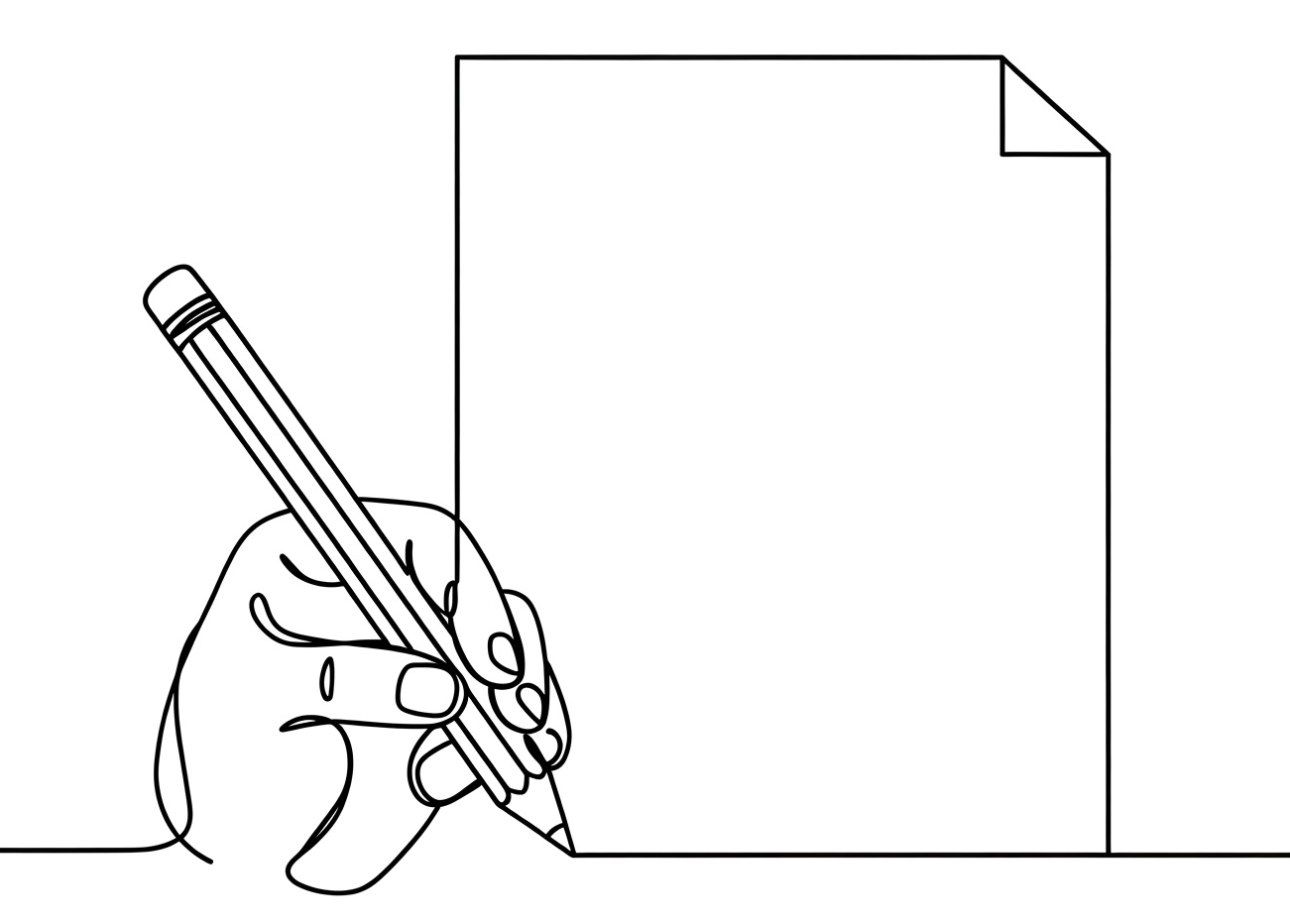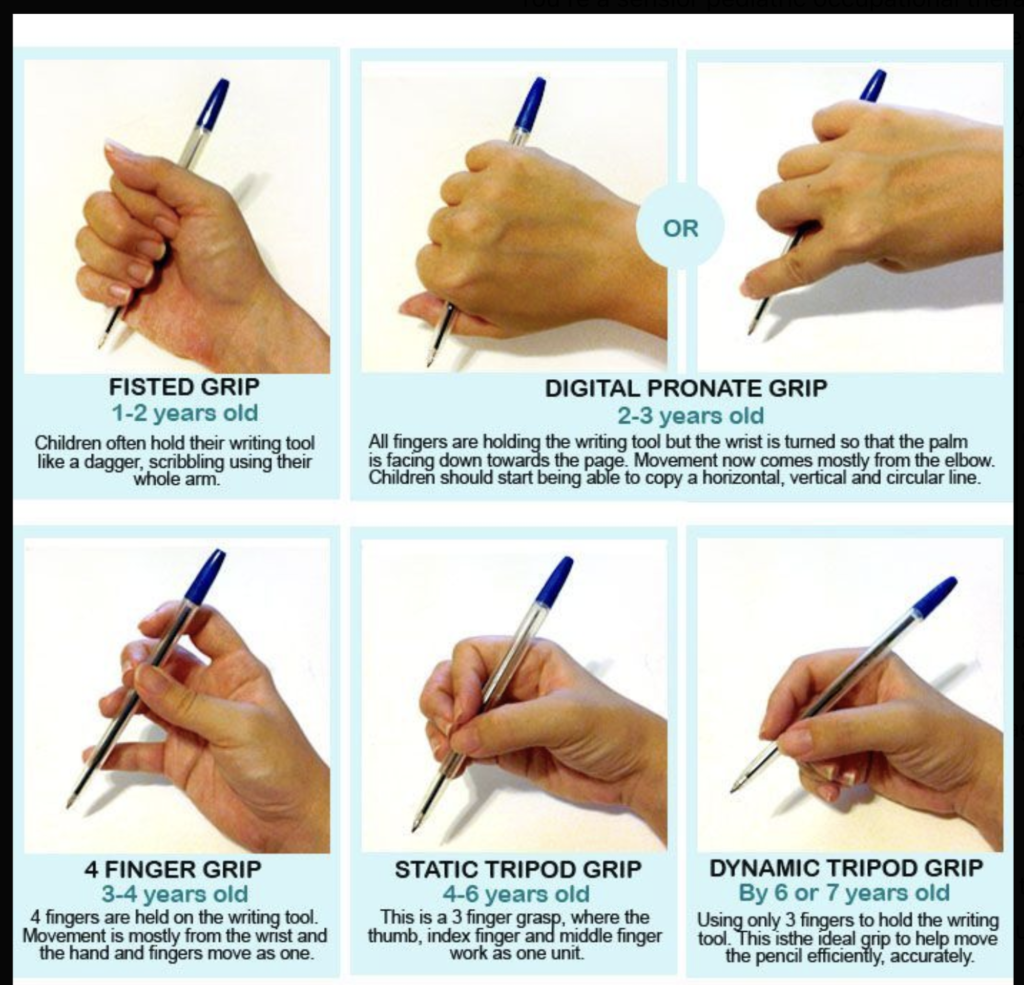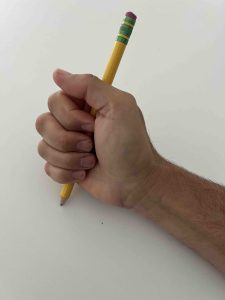
Palmar Supinate Grasp (fisted grasp).
-
The pencil is held in the fist.
-
The thumb is positioned at the top, with movement coming mostly from the shoulder and elbow rather than the fingers.
-
The wrist is often turned so the palm faces downward or sideways while writing.
This grasp is developmentally typical around 12–18 months of age.
-
It emerges when toddlers first begin using crayons or markers to make scribbles.
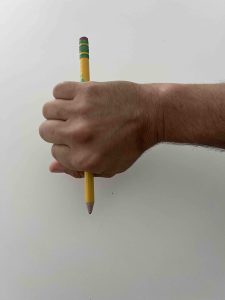
Digital Pronate Grasp.
-
The pencil is held with the fingers (not the fist).
-
The palm faces down toward the paper (pronated position).
-
The index finger often points down toward the tip of the pencil, while the other fingers wrap around it.
-
Writing movement begins to shift more to the forearm and wrist, but still not yet finger-controlled.
-
This grasp typically develops around 2–3 years old.
-
It’s the natural progression after the Palmar Supinate Grasp.
-
Children using this grasp can make stronger, more controlled marks than with the fisted grasp.
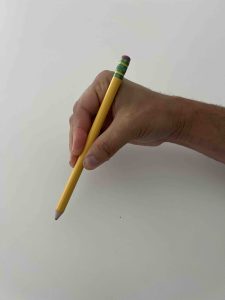
Pronated Brush Grasp (“overhand grasp”).
The pencil is held with all fingers extended, almost like holding a paintbrush.
The thumb is placed opposite the fingers, stabilizing the tool.
The wrist is pronated (palm facing downward), and movement comes mostly from the shoulder and elbow, not the fingers.
Typically used for large, sweeping strokes rather than controlled fine motor writing.
Common around 2–3 years old, especially during early scribbling and coloring.
It’s considered a transitional grasp, appearing after the palmar supinate grasp but before more refined tripod/quadrupod grasps..
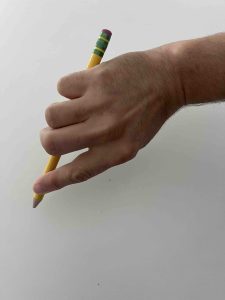
Static Quadrupod Grasp
Pencil is held with four fingers: thumb, index, middle, and ring fingers.
The grasp looks stable, but movement comes mostly from the wrist and arm, not isolated finger movements.
Fingers are relatively stiff, which limits precision and endurance.
It’s similar to the static tripod, but with an extra finger added for support.
Typically seen around 3½–4½ years old..
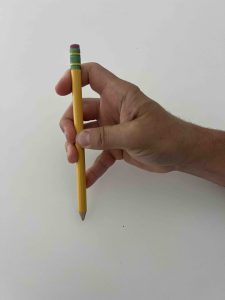
Static Tripod Grasp
The pencil is held between the thumb and index finger, with the middle finger providing support underneath.
The pencil rests against the side of the hand.
The wrist and forearm do most of the movement, while the fingers remain fairly stiff (hence “static”).
It’s more refined than the digital pronate but not yet fluid finger-controlled.
Typically emerges around 3½ to 4 years old.
Considered a normal transitional grasp as fine motor control improves..
👉 If this grasp persists into the early school years without transitioning to a dynamic tripod or quadrupod, it may impact writing endurance, speed, and legibility.
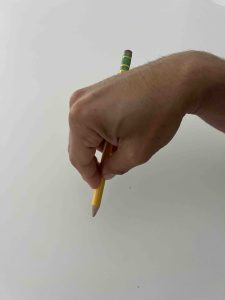
Cross Thumb Grasp
Pencil is held with thumb and index finger, supported by the middle finger.
-
Pencil rests in the web space between thumb and index finger.
-
Small, isolated finger movements control the writing tool, while the hand, wrist, and arm stay relatively stable.
-
Allows for speed, endurance, and precision in handwriting.
-
Typically develops between 4½ and 6 years old.
-
Considered the optimal grasp for school-age children.
-
If present, no further correction is usually needed unless the grasp is awkward (e.g., excessive thumb wrap or hyperextension).
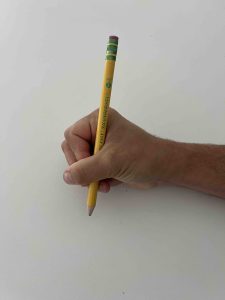
Dynamic Quadrupod Grasp.
-
The pencil is held with four fingers: thumb, index, and middle fingers control the pencil, while the ring finger provides extra stability underneath.
-
Pencil rests in the web space between thumb and index finger.
-
Like the dynamic tripod, the movement is controlled by small, isolated finger motions, not the wrist or arm.
-
Considered functionally mature and efficient, even though one extra finger is involved.
-
Usually develops around the same time as the dynamic tripod grasp (4½–6 years).
-
Considered an acceptable mature grasp for handwriting.
-
Many children and adults naturally use a quadrupod instead of a tripod without negative impact on legibility, speed, or endurance.
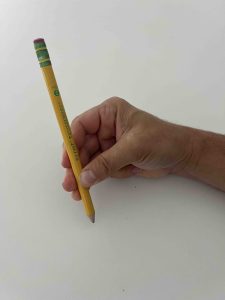
Static Tripod Grasp with Extended Fingers
-
Pencil is held with thumb, index, and middle finger (tripod), but the fingers are extended and straight instead of flexed.
-
Pencil rests against the index finger rather than in the web space.
-
Movement comes from the wrist and arm, not the small joints of the fingers.
-
This limits precision, endurance, and speed compared to a dynamic tripod.
-
Common as a transitional grasp between ages 4–6.
-
Children may use this before refining into a dynamic tripod grasp, where fingers bend and move independently.
-
If it persists past age 6–7, it may cause writing fatigue or reduced legibility due to inefficient motor mechanics.
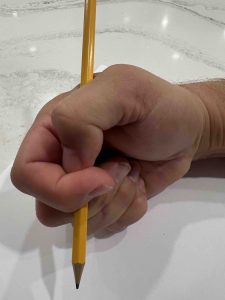
Interdigital Brace Grasp
-
Description: Pencil is stabilized between two fingers (often index and middle) rather than resting in the web space.
-
Concerns: Less efficient control; can be functional but not ideal.
-
Age: Sometimes seen in older children or adults as a compensatory grasp.
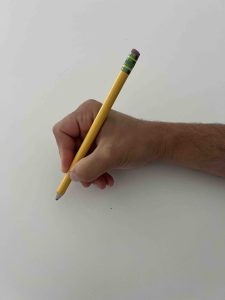
Dynamic Tripod Grasp — the gold standard for handwriting.
-
Pencil is held with three fingers: thumb, index finger, and middle finger.
-
Pencil rests in the web space between thumb and index finger.
-
Writing is controlled by fine, isolated finger movements rather than wrist or arm.
-
Provides the most efficient balance of stability, precision, speed, and endurance.
-
Usually emerges between 4½–6 years old.
-
This is the mature, functional grasp expected in elementary school and adulthood.
-
If achieved, no intervention is needed unless the grasp is paired with other inefficiencies (e.g., excessive pressure, thumb wrap, fatigue).
